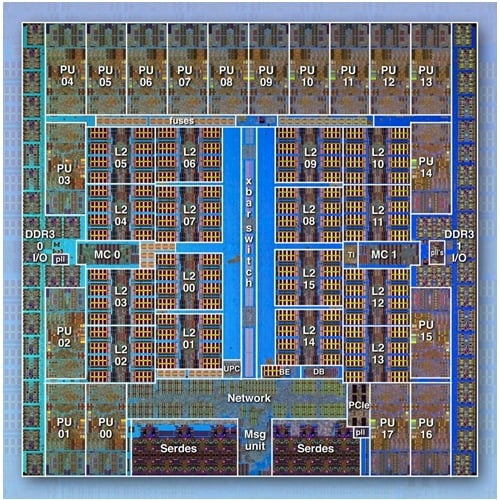*********************************************
IBM's BlueGene/Q super chip grows 18th core
*******************************EXCERPTS*******************************************
By Timothy Prickett Morgan
22nd August 2011 17:00 GMT
It's nice to have a spare
Hot Chips The mystery surrounding the number of cores in the 64-bit Power processor that will be at the heart of the 20 petaflops "Sequoia" BlueGene/Q supercomputer has been finally cleared up.
Back at the SC10 supercomputing conference in November 2010, a software engineer working on the BlueGene/Q system told El Reg that the processor module at the heart of the system would have 17 cores: one to run the Linux kernel and the 16 others to perform mathematical calculations. IBM also said at the time that this chip would be a variant of the PowerA2 "wirespeed" processor, but geared down to 1.6GHz from its 2.3GHz design speed.
In February 2011, when Argonne National Laboratory said that it was going to take a 10 petaflop super based on the BlueGene/Q design (basically half of the Sequoia machine that is going into Lawrence Livermore National Laboratory), IBM told El Reg that it was just a 16-core chip, nothing funky.
For whatever reason, neither turns out to be true. The BlueGene/Q processor, the company revealed at the Hot Chips conference at Stanford University late last week, actually has 18 cores: 16 cores for doing work, one core for running Linux services, and a spare that is intended to merely increase the yield that IBM Microelectronics can get out of its chip fabs but which can, according to George Chiu, senior manager of advanced high performance systems at IBM, be activated and used in the system, in theory.
Chiu was very clear, however, that he was not making any promises that this 18th core would be used as a hot spare in any BlueGene/Q supers, but merely that the capability is there.
Big Blue detail
IBM gave out a lot more detail on the BlueGene/Q processor at Hot Chips, and Chiu walked El Reg through the details. The chip looks like this:

The BlueGene/Q custom Power processor
Like other processor designs these days, the BlueGene/Q processor is an example of a system-on-a-chip design, which tries to cram as many components of the system board onto the chip. The BlueGeneQ processor is based on the Power A2 core that IBM created for networking devices and experimentation, and this is the block diagram of the core:
